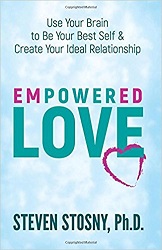
 Empowered Love
Empowered LoveUse Your Brain to Be Your Best Self & Create Your Ideal Relationship
Reviewed March 9, 2018.
Ixia Press, 2018. 226 pages.
Starred Review
Steven Stosny is my favorite author on relationships. If you have a relationship with a lot of anger between partners, I highly recommend Love Without Hurt (also known as You Don’t Have to Take It Anymore). I know from experience, this book really can help you transform your anger into compassion, and reinforce your own core value.
If you’re dealing with betrayal, I also recommend from personal experience the book Living and Loving After Betrayal. It will help you heal and help you move on.
This book, Empowered Love, I think will help relationships that are good get better and relationships that are sinking come up for air. This time, I can’t speak from personal experience, but I hope someday to try the ideas out!
As in his other books, he reminds the reader that we feel lovable when we are more loving, and we feel valuable when we treat others as valuable.
This book is an expansion of his work in the book Soar Above, bringing the ideas presented there into the realm of love relationships. Both books help you rise above your conditioned responses – the ways you learned to respond as a toddler, which he calls your Toddler Brain.
I realized fairly early in writing Soar Above that I had to write a separate book to accommodate the special challenges of committed love relationships. These occur on an altogether different playing field from those of work and social life. As we’ll see, many of the problems of love relationships stem from partners who behave at home in ways that might serve them well in work and social gatherings but fail miserably in love relationships. No important human endeavor makes it harder to stay consistently in the profoundest part of the brain than interactions with loved ones. The simple explanation of why this is so is that living with someone invokes a wide array of routine behaviors, running on autopilot, without forethought or conscious intention. Routine ways of behaving are likely to stimulate old emotional habits when stressors are added to the mix, such as quarreling children, urgent text messages from work, or overdue bills. The Toddler brain by habit looks for someone to blame, denies responsibility, or avoids the issue altogether.
The more subtle reason that we’re apt to invoke Toddler-brain habits in committed relationships lies at the very heart of love. The same quality that makes love wonderful – giving fully of the deepest parts of ourselves – also makes it a little scary. Most lovers have not felt so emotionally dependent and powerless over their deepest vulnerable feelings since they learned to walk. Similarities in vulnerability can fool the brain under stress and increase the likelihood of invoking Toddler-brain ways of coping in love relationships. Most of the hundreds of couples I’ve treated were fine at work and with friends, smart, resourceful, and creative. But at home they were like playground kids pointing out each other’s faults: “It takes one to know one!” Most were compassionate and kind to other people, but to each other they were opposing attorneys in a bitter lawsuit.
Like his other books, this book is rooted in value. Here’s where he talks about value in the beginning of the section on Adults in Love:
To grasp the psychological function of values, it’s useful to think in terms of the verb to value rather than the noun values. To value someone or something goes beyond regarding that person or object as important; you also appreciate certain qualities, while investing the time, energy, effort, and sacrifice necessary for successful maintenance. If you value a da Vinci painting, you focus on its beauty and design more than the cracks in the paint, and, above all, you treat it well, making sure that it is maintained in ideal conditions of temperature and humidity, with no harsh or direct lighting. Valuing loved ones requires appreciation of their better qualities and showing care for their physical and psychological health, growth, and development.
The experience of value gives a heightened sense of vitality – you feel more alive looking at a beautiful sunset, connecting to a loved one, knowing genuine compassion for another person, having a spiritual experience, appreciating something creative, committing to a cause, or identifying with a community. Valuing gives a greater sense of authenticity and often a greater sense of connection. High value investment gives meaning and purpose to life, with a stronger motivation to improve, create, build, appreciate, connect, or protect.
This isn’t a book about improving communication.
Couples whose interactions are dominated by the Toddler brain often fool themselves into thinking their high emotional reactivity – if not all their problems – is rooted in poor communication. Sadly, they find lots of reinforcement for this pervasive myth in pop psychology, where catchy notions that lack empirical support or theoretical validity reign supreme. The great cliché about intimate relationships is that they are all about communication and that communication is all about talking….
In intimate relationships, verbal communication is a function of connection, rather than the other way around. When people feel connected, they’re able to talk and listen with ease. When they feel disconnected, they tend to attack and counterattack, however cleverly hidden in verbal skills, as they blame each other for the pain of disconnection. Both partners seem to imply:
“I cannot love you until you agree with me or see things my way or express them the way I think you should.”
If partners are motivated to attack or avoid, employing even the most sophisticated communication skills will make them appear phony and manipulative. In my quarter-century of clinical practice, I have never seen skillful communication form a connection without a sincere desire to connect, nor have I seen poor communications skills or choice of words interfere with a sincere desire to connect.
Adults in love don’t try to communicate in order to connect. They connect in order to communicate.
There’s a small chapter on Metaphors, which toddlers don’t understand. If you think of your marriage with a positive metaphor, it will help you love like an adult. Several strong metaphors were given as examples, and I especially liked this one:
Love is like a musical duet. In a duet, both musicians are able to make beautiful music on their own. But together they make something greater than either can do alone: harmony.
Harmony is an appealing combination of elements in a whole. In music, it’s an arrangement of sounds pleasing to the ear. Harmony in intimate relationships is more about emotional tone and atmosphere than expressions of love or specific behaviors. It’s about both partners thriving and growing into the best musicians they can be. You stop making harmony when the Toddler brain dominates the relationship, simply because it cannot balance the drives for autonomy and connection. In the Toddler brain, all you can do is try to criticize or stonewall the violin into becoming the cello, and vice versa.
Harmony rises from partners attuned to their deepest values, which will necessarily include compassion and kindness for each other. The foundation of relationship harmony is frequent notes of compassion and kindness, focused on the long-term best interests of both partners. Focusing on compassion and kindness, rather than on being right or wrong, creates the sort of relationship harmony that keeps the drives for autonomy and connection in balance, and creates Power love.
There’s lots more here, but that gives you the idea. This is about building a relationship on compassion and valuing each other. It has many ideas for getting back on track if your relationship is going astray from that, but trying these things is going to make you feel better about yourself even if your spouse never does get on board.
If they do join you in this kind of a relationship? I do think you will soar. I hope I get to try it sometime!
